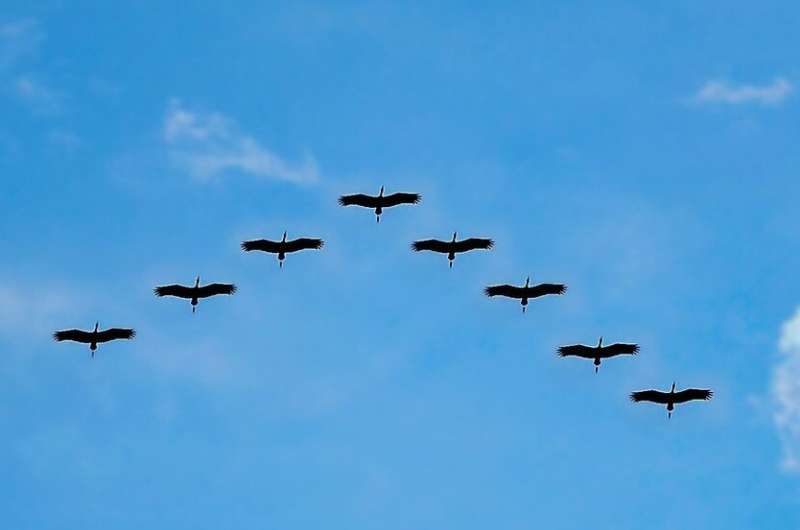This article has been reviewed according to Science X's editorial process and policies. Editors have highlighted the following attributes while ensuring the content's credibility:
fact-checked
trusted source
written by researcher(s)
proofread
Viewpoint: Migratory animals face mass extinction—but as a conservationist, I'm optimistic

The world is facing three planetary crises: biodiversity loss, climate change and environmental pollution. Recognized threats to biodiversity include habitat loss and overexploitation but new analyses suggest that migratory species are faring particularly badly.
The global extinction risk is increasing for all migratory species. Importantly, however, there is cause for optimism.
I'm writing this in Samarkand, Uzbekistan, for the 14th Conference of the Parties to the Convention on Migratory Species. This UN biodiversity treaty came into being in 1983 to support the conservation and sustainable use of migratory species.
I'm here with representatives of many of the world's governments, United Nations agencies and various environmental organizations. The aim of the meeting is to review implementation of the convention, consider including additional species under the treaty and address emerging issues of concern for migratory species.
This is a flagship event. It is the first time that member countries have met in person since the COVID pandemic and the first such meeting ever to be held in Central Asia.
Status update
A landmark report titled the State of the World's Migratory Species has been launched at the meeting, the first ever report of its kind. The results are alarming.
They indicate that three in four species included under the convention are affected by habitat loss, degradation and fragmentation and seven in ten listed species are threatened by direct use and trade to varying degrees. Worse still, they suggest that the extinction risk is increasing for all migratory species, including those not included under the convention.
Some species are of particular concern. Populations of fish included under the convention have declined on average by 90% since 1970. Many species under the convention that need or would significantly benefit from international cooperation, are identified as high priorities for further conservation action based on their conservation status and biological vulnerability.
These include 90 species of bird (including the whooping crane), 18 terrestrial mammals (such as the African hunting dog) and 12 aquatic mammals (such as the Amazon river dolphin). In some cases, this is despite these animals having been listed under the convention for decades.
This report is important because it details the range of threats that migrating species face. Animals migrate for various reasons including to find food, to reproduce, and ultimately to survive. Importantly, they do not respect national borders.
They may also face different threats along migration routes. Understanding the scope and severity of these threats where they occur is therefore essential to informing conservation action, especially in the context of the triple planetary crises.
Effective action
More broadly the report is important because it enables an assessment of how conservation efforts to conserve migratory species listed under the convention are working or if they are not. The results also call into question the effectiveness of the convention itself.
The effectiveness of multilateral environmental agreements can be measured in various ways but arguably the most critical measure of effectiveness is whether such agreements are solving the problem for which they were designed.
There are various reasons why such agreements are not always as effective as they could be. These include a lack of political will, a lack of resources to identify and implement context-specific measures at relevant scales and a lack of resources for law enforcement.
Success stories do shine through, though. Native to central Asia, the saiga antelope was included in the convention in 2006. This has proven key to catalyzing concerted conservation action for the saiga.
In 2006, all range countries for this species, including Kazakhstan and Uzbekistan, also signed a memorandum of understanding vowing to restore saiga populations by improving monitoring, reducing poaching and illegal trade and creating alternative livelihood options for local communities.
Saiga range countries are well on their way to achieving this objective. In the last 15 years, new knowledge of the saiga antelope's ecology, migration and trade has been generated and effective anti-poaching measures have been implemented.
As a result, the saiga was moved from critically endangered to near threatened on the International Union for Conservation of Nature red list of threatened species in 2023. This has been possible because of political will in range countries but also because of collaboration between government agencies, conservation practitioners, environmental organizations and academics.
Here in Samarkand, this collaborative effort is clear to see. For the saiga, collaborators have focused on several aspects of the species' conservation. These include evaluating management approaches, sustainable use of the species, stockpile management, building the saiga conservation network and identifying key research needs along international supply chains.
Catalyzing cross-border conservation
While headlines are bleak, I feel optimistic. This landmark meeting has been positive and I've noticed a renewed sense of commitment to improve the conservation of migratory species. There is a clear sense that the governments gathered here know what they need to do. It is now about getting on and doing it.
This reflects the fact that the scientific community does know how to conserve species. Conservation measures should be context-specific, applied at relevant scales, and socially legitimate among local communities and Indigenous peoples if they are to be successful.
Renewed commitment to conservation solutions identified in this report could build political will to act together. If member countries can rise to the challenge, then there is hope for the world's migratory species.
Provided by The Conversation
This article is republished from The Conversation under a Creative Commons license. Read the original article.![]()




















